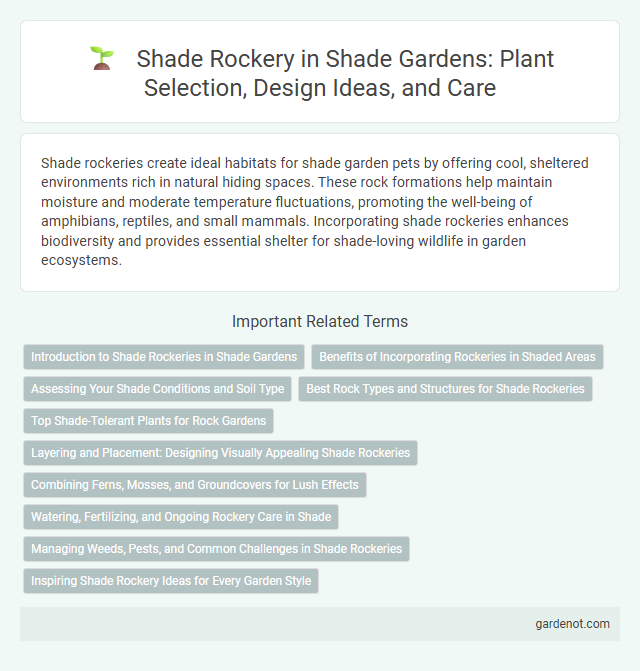Shade rockeries create ideal habitats for shade garden pets by offering cool, sheltered environments rich in natural hiding spaces. These rock formations help maintain moisture and moderate temperature fluctuations, promoting the well-being of amphibians, reptiles, and small mammals. Incorporating shade rockeries enhances biodiversity and provides essential shelter for shade-loving wildlife in garden ecosystems.
Introduction to Shade Rockeries in Shade Gardens
Shade rockeries enhance shade gardens by combining natural stone formations with shade-tolerant plants like ferns, hostas, and astilbes. These rockeries improve soil drainage and create microclimates that support diverse, low-light vegetation. Incorporating mosses and textured foliage adds depth and visual interest to shaded garden spaces.
Benefits of Incorporating Rockeries in Shaded Areas
Incorporating rockeries in shaded areas enhances soil drainage and prevents erosion, creating a stable environment for shade-loving plants to thrive. The varied textures and elevations of rockeries improve microclimates, promoting biodiversity by offering niches for mosses, ferns, and groundcovers. Rockeries also add visual interest and structure to shade gardens, transforming underutilized spaces into dynamic, low-maintenance landscapes.
Assessing Your Shade Conditions and Soil Type
Assessing your shade conditions involves identifying the type and duration of shade--whether dense, dappled, or partial--since plants vary in light tolerance. Measuring soil type, including pH, drainage, and nutrient levels, is crucial for selecting rockery plants that thrive in shaded areas. Understanding these factors ensures the successful establishment of a shade rockery that supports healthy plant growth and aesthetic appeal.
Best Rock Types and Structures for Shade Rockeries
Shade rockeries thrive with rock types like bluestone, sandstone, and granite, which offer durability and natural aesthetics while retaining moisture essential for shade-loving plants. Layered structures with varying rock sizes create pockets for soil and plant roots, enhancing water retention and providing microhabitats for ferns, hostas, and mosses. Incorporating flat, broad rocks ensures better shade coverage and cooler soil temperatures, crucial for healthy shade garden growth.
Top Shade-Tolerant Plants for Rock Gardens
Shade rockeries thrive with top shade-tolerant plants like hostas, ferns, and heucheras, which provide lush foliage and vibrant texture in low-light areas. Astilbe and pulmonaria add striking blooms and seasonal color, enhancing the visual appeal of shaded rock gardens. Incorporating these shade-loving perennials creates a resilient, low-maintenance landscape that flourishes under tree canopies or in shadowed garden corners.
Layering and Placement: Designing Visually Appealing Shade Rockeries
Layering and placement in shade rockeries create depth and texture by arranging plants and rocks in staggered heights and densities. Using a mix of shade-tolerant ferns, hostas, and mosses combined with strategically positioned stones enhances visual interest while optimizing light and moisture conditions. Careful consideration of rock sizes and plant spacing ensures a harmonious balance that mimics natural forest floor environments.
Combining Ferns, Mosses, and Groundcovers for Lush Effects
Shade rockeries achieve lush effects by combining ferns, mosses, and groundcovers that thrive in low-light conditions. Fern varieties like the Japanese painted fern and lady fern provide intricate foliage textures, while mosses such as cushion moss add soft, vibrant green layers. Groundcovers including ajuga and bergenia fill gaps with dense, spreading growth, creating a rich, multi-dimensional shade garden landscape.
Watering, Fertilizing, and Ongoing Rockery Care in Shade
Watering a shade rockery requires maintaining consistently moist soil without waterlogging, as shade plants generally prefer moderate hydration to prevent root rot. Fertilizing should be done with a balanced, slow-release fertilizer in early spring to support steady growth and enhance the nutrient-poor conditions typical in shaded areas. Ongoing rockery care involves regular removal of debris, monitoring for moss or algae buildup on rocks, and occasional pruning of shade-loving plants like ferns and hostas to preserve air circulation and prevent overcrowding.
Managing Weeds, Pests, and Common Challenges in Shade Rockeries
Effective management of weeds, pests, and common challenges in shade rockeries involves selecting shade-tolerant ground covers and mulch to suppress weed growth and retain soil moisture. Regular monitoring for pests like slugs, snails, and aphids enables early intervention using organic or chemical controls tailored for shaded environments. Proper drainage and soil aeration reduce fungal diseases common in moist, shaded areas, ensuring a thriving shade rockery ecosystem.
Inspiring Shade Rockery Ideas for Every Garden Style
Shade rockeries transform dim garden corners into stunning focal points by combining textured rocks with shade-loving plants like ferns, hostas, and astilbes. Incorporating natural stone arrangements and layered planting enhances depth and visual interest, creating serene retreats that thrive under low light conditions. Tailoring rock and plant selections to suit woodland, Japanese, or modern garden styles ensures a harmonious blend of shade rockery elements for inspiring outdoor spaces.
Shade rockery Infographic

 gardenot.com
gardenot.com